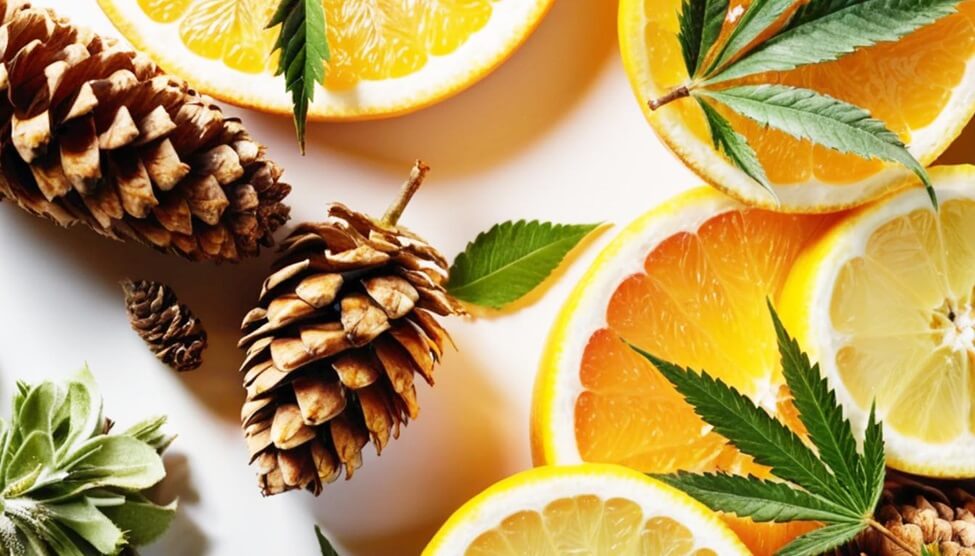Diving into the world of cannabis is like stepping into a vast garden of sensory experiences, each plant offering its own unique vibe. At the heart of these experiences are cannabis terpenes, the aromatic oils that color cannabis varieties with distinctive flavors like citrus, berry, mint, and pine. Knowing your terpenes can dramatically enhance your visit to any cannabis dispensary, turning a routine purchase into an exciting exploration of smells and effects. Terpenes don’t just tickle your senses; they play a significant role in defining how a strain might influence your mood and perception, making them a hot topic not just for the cannabis curious but for anyone seeking to deepen their understanding of this complex plant.
What Are Cannabis Terpenes?
Terpenes are the primary constituents of essential oils and play a crucial role in the aromatic characteristics of cannabis. These naturally occurring chemical compounds are responsible for the diverse aromas and flavors found in various cannabis strains, influencing consumer experiences and market price significantly.
The Science Behind Terpenes
Terpenes are classified into different types based on their molecular structure. The most common types in cannabis are monoterpenes and sesquiterpenes. Each terpene has a unique boiling point, which is why different temperatures release different aromas and effects when cannabis is heated.
The Major Terpenes in Cannabis
Let’s get to know some of the most prevalent terpenes in cannabis, their aromas, and their effects.
Myrcene
Aroma: Earthy, musky, with a hint of cloves.
Effects: Known for its relaxing and sedative effects. Myrcene is often found in indica strains and is thought to enhance the psychoactive effects of THC.
Limonene
Aroma: Citrus (lemons, limes, oranges).
Effects: Uplifting and mood-enhancing. Limonene is often found in sativa strains and is believed to have calming and uplifting properties.
Pinene
Aroma: Pine needles, rosemary, basil.
Effects: Promotes alertness and memory retention. Pinene is found in both indica and sativa strains and is thought to counteract some of the memory loss associated with THC.
Linalool
Aroma: Lavender, floral.
Effects: Calming and stress-relieving. Linalool is commonly found in indica strains and is used for its potential calming and rest-enhancing effects.
Caryophyllene
Aroma: Spicy, peppery, woody.
Effects: Known for its anti-inflammatory and relief properties. Caryophyllene is unique because it can also interact with cannabinoid receptors directly, making it a cannabinoid-like terpene.
Humulene
Aroma: Earthy, woody, herbal (hops).
Effects: Appetite suppressant and anti-inflammatory. Humulene is often found in strains that are reported to reduce appetite or have anti-inflammatory effects.
Terpinolene
Aroma: Herbal, floral, citrus.
Effects: Often provides a relaxing yet uplifting effect. Terpinolene is a jack-of-all-trades terpene, offering a mix of calming and stimulating effects depending on the cannabinoid system of the person consuming it, and if it is combined with other terpenes.
The Role of Terpenes in Cannabis Experience
Understanding the terpene profile of a cannabis strain can help you choose the right product for your desired effects. Here’s how terpenes influence your cannabis experience.
Flavor and Aroma
Terpenes are responsible for the wide variety of flavors and aromas found in cannabis. Whether you prefer fruity, earthy, or spicy strains, there’s a terpene profile to match your taste.
Effects on Mood and Mind
Different terpenes can enhance or modify the effects of THC and CBD. For example, a strain high in limonene might provide an uplifting, energetic experience, while one rich in myrcene may be more relaxing and supportive of sleep.
Therapeutic Benefits
Terpenes also have potential therapeutic benefits. For instance, linalool is being studied for its potential calming properties, while caryophyllene might be beneficial for managing inflammation and discomfort.
How to Identify Terpenes in Cannabis
So, how can you tell which terpenes are in your cannabis? Here are a few tips.
Read the Label
Many dispensaries and cannabis brands now include terpene profiles on their packaging. Look for information on the dominant terpenes in the strain you’re considering.
Smell Test
Your nose knows! Take a moment to smell the cannabis before you buy it. If you detect a strong citrus scent, it’s likely high in limonene. A piney aroma indicates pinene, while a lavender-like smell suggests linalool.
Lab Reports
For the most accurate information, check the lab report or certificate of analysis (COA) for your cannabis product. These reports provide a detailed breakdown of the cannabinoid and terpene content.
Afterthoughts
Terpenes are the unsung heroes of the cannabis plant, providing a symphony of aromas, flavors, and effects. By understanding terpenes, you can make more informed choices and enhance your cannabis experience. Whether you’re seeking relaxation, creativity, relief, or just a delightful sensory journey, the right terpene profile can make all the difference.
So, the next time you find yourself at a cannabis dispensary, take a moment to appreciate the terpenes. Smell the flowers, read the labels, and savor the rich, aromatic world of cannabis terpenes. Happy exploring!
Disclaimer: the information provided in this document is for informational purposes only and is not intended as a substitute for professional medical advice, diagnosis, or treatment.

Our Top Brands

5G Pops Product Spotlight







